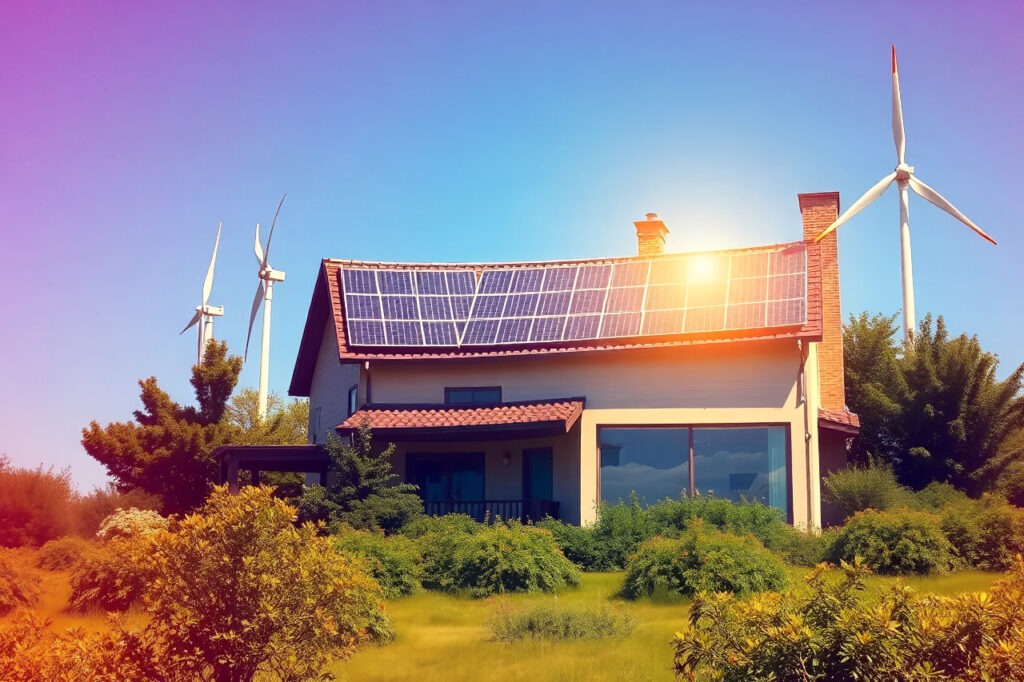Dieser Beitrag ist auch verfügbar auf:
Deutsch
1. Photovoltaic Systems
Photovoltaic systems are one of the most efficient ways to generate renewable energy. The versatility of this technology and its ever-decreasing costs make it one of the world’s most popular solutions for creating electricity. Not only is it future-proof, it is also a key component of the energy transition.
The benefits of photovoltaics
- After making the initial investment, users can enjoy virtually free electricity for decades. In many regions, the return of investment period for photovoltaic systems has now dropped to around 5 to 10 years, with installation costs continuing to plummet year on year.
- Photovoltaic systems are extremely durable and require little maintenance. Solar cells have a lifespan of 25 to 30 years and lose efficiency very slowly. Maintenance is usually limited to cleaning the solar cells and periodically inspecting the system.
- One of the greatest strengths of photovoltaics is the ability to store the electricity that has been generated. Thanks to modern battery storage, users can also employ self-generated energy at night or on cloudy days. Storage technology significantly reduces dependence on the public power grid.
Downsides of photovoltaic systems
- Buying and installing a photovoltaic system requires an initial investment of at least four figures. However, government subsidies and tax breaks are making this technology more affordable with each passing day. In many countries, it is also possible to reduce costs through subsidized loans or tax incentives, making it easier for individuals and businesses to get started.
- A major drawback of solar energy is its dependence on sunlight. However, this issue is mitigated by combining photovoltaic systems with battery storage and other renewables.
Latest innovations in photovoltaics
Perovskite solar cells
This technology may replace traditional silicon solar cells. In addition to being lighter and more flexible, perovskite solar cells are also cheaper to produce. They can be integrated into a wide range of surfaces and even flexible materials, making them suitable for a wider range of applications.
Agricultural Photovoltaics
This innovative solution combines agriculture and solar energy by installing solar panels over agricultural structures. This arrangement protects the crops underneath from extreme weather conditions such as heat, hail and heavy rain, while generating electricity.
Trivia
Photovoltaic systems can even generate electricity in moonlight. While the amount of electricity generated in this case is minimal, it shows the impressive potential of photovoltaic systems to work even in low light.
2. Wind turbines
Wind power is one of the most popular and efficient methods of generating renewable energy. In addition to large offshore and onshore wind farms, small wind turbines are also becoming more and more important. They offer a promising opportunity for self-sufficient energy supply, particularly in windy regions and remote areas where grid connection is difficult or expensive.
Advantages of small wind power systems
- In regions with consistent wind conditions, small wind turbines provide a continuous and reliable source of energy. They produce electricity even at moderate wind speeds.
- In rural or remote regions where connecting to the power either poses technical or financial disadvantages, small wind turbines are particularly useful. They offer a cost-effective way to achieve self-sufficiency and avoid high connection costs.
- In combination with other renewable energies such as solar power combined with battery storage, small wind turbines can help to achieve complete independence from the public power grid.
Downsides of small wind power systems
- Noise from the rotors can be disruptive in rural areas and affect the acceptance of local residents. The systems can also be visually intrusive, especially in sensitive areas. These factors need to be taken into account during planning and construction.
- In many countries, the installation of small wind turbines is subject to strict regulatory requirements. These regulations cover site selection, wind speed and other environmental factors.
Latest innovations in wind power
The technology in the field of wind power is constantly evolving. The integration of micro wind turbines into urban infrastructures in particular shows great potential.
Micro wind turbines on lampposts
In Japan, micro wind turbines are installed directly on street lamps to provide lighting with renewable electricity. This compact solution uses local wind resources to power street lighting without additional grid infrastructure. This type of integration of wind power into urban infrastructure could be expanded further in the future, especially in densely populated, windy regions.
Floating wind turbines
These types of turbines can be placed on the water’s surface where the wind is constant and strong. They have the potential to generate large amounts of renewable energy without taking up valuable land. This technology could play an important role in the offshore wind industry in the coming years.
Unusual applications of wind power
Vertical wind turbines
Compared to traditional horizontal wind turbines, vertical wind turbines are becoming increasingly common. They take up less space and are quieter, making them an attractive option for urban areas or smaller sites. They can also operate more efficiently in varying wind directions and are more resilient to wind peaks.
Wind energy from sewers
Some pilot projects are using the flow of water in canals to power small turbines. This technology could provide a sustainable way to increase energy production in urban areas while using wastewater treatment infrastructure.
3. Hydropower
One of the oldest and most reliable methods of generating renewable energy. Small hydropower plants in particular are becoming increasingly important as they offer an efficient and locally applicable solution for generating electricity.
Advantages of small hydropower
- Unlike many other renewable energy sources, electricity production from hydropower is consistent and predictable. In areas with flowing water, small hydropower plants can provide energy around the clock.
- Hydropower plants have an extremely long lifespan – many plants can remain in operation for 50 years or more, making the initial investment very profitable in the long run.
Downsides of small hydropower
- The construction of a small hydropower plant can require high financial resources as it requires tailor-made solutions. In mountainous areas or remote regions in particular, infrastructure such as access roads and utilities must be built.
- Even though small hydropower plants have less impact on the ecosystem than dams, their installation can still affect local flora and fauna. Changing river courses and building dams can disturb the habitat of animals and plants and alter the natural flow of water.
Latest innovations in hydropower
Floating hydroelectric power plants
Floating hydroelectric plants make it possible to use water resources without using land. These plants consist of floating platforms equipped with turbines that float on the surface of lakes or rivers. This technology is particularly suited to areas with limited access to land, and also has the advantage of preventing the siltation of water bodies.
Hydrokinetic turbines
Hydrokinetic turbines use the flow force of the water directly to generate energy. These turbines can also be used in rivers with low currents or in tidal zones. They are an environmentally friendly and flexible solution as they do not require major interventions in the environment and can be easily integrated into existing water structures.
Micro-hydro for use in sewers
Another innovative application of hydropower is the use of canals or small streams to drive turbines and generate electricity. This technology is emerging as a cost-effective and environmentally friendly solution, particularly in urban areas. It has the potential to improve the efficiency of sewer systems while also contributing to electricity generation.
Unusual Applications of Hydropower
Energy from Wastewater
Some pilot projects are using the flow of wastewater to generate electricity. In urban areas where sewers already exist, this technology could make energy production more efficient. It involves installing turbines in sewers that rotate and generate electricity using natural water pressure or river movements.
The Archimedean screw
This ancient principle is starting to see more use in modern small hydroelectric power plants. The Archimedean screw is a cylindrical device that lifts the water of a river or stream and diverts it into a turbine to generate electricity. The Archimedean screw has proven to be particularly efficient, especially in shallow waters and with small differences in height, as it has less impact on the environment and delivers a high energy yield. It only has a minimal impact on the natural flow of water.
4. Biomass
Biomass is one of the oldest and most effective methods of generating renewable energy. It uses organic materials such as wood, plant residues, agricultural waste or even industrial waste to generate heat and electricity. Biomass is not only an important resource for generating energy, but also plays a central role in waste management by making sensible use of organic materials.
Benefits of biomass
- Biomass plants offer a valuable way to utilize organic waste. This includes not only plant waste, but also waste products from the food industry, as well as wood residues and agricultural waste.
- Biomass can be utilized in various forms, be it in biomass cogeneration plants, biogas plants or to produce biofuels for transport and industry. This versatility makes biomass an important pillar of renewable energy.
- Because biomass can be produced locally, it offers benefits for the rural economy. It promotes local jobs in agriculture and waste management and can increase security of supply in remote regions.
Weaknesses of Biomass
- For biomass power plants to operate efficiently, a regular and reliable supply is required. Obtaining sufficient biomass in sufficient quantities can be a challenge, especially in rural areas.
- Inappropriate use of biomass, such as the destruction of forests for wood production, can have negative environmental impacts. It is crucial that biomass comes from sustainable sources and is used responsibly.
- Some biomass plants, such as biogas plants, require large areas to grow feedstocks such as corn or rapeseed. This can lead to a conflict with other agricultural uses, such as food production.
Latest innovations in biomass
Mini biogas plants for households
Smaller, decentralized biogas plants designed specifically for households or small farms can efficiently convert kitchen waste and other organic materials into biogas. These mini-biogas plants not only provide a sustainable way to dispose of waste, but also a valuable source of energy for heating and electricity.
Biorefineries
In this case, biomass is used not only to produce energy, but also to produce biochemicals, fertilizers and bioplastics. This technology could help make a variety of industrial processes more sustainable in the future.
Biomass liquefaction
The latest research makes it possible to convert solids such as wood or agricultural waste into liquid biofuels. These fuels can then be integrated into existing fossil fuel infrastructures, thus offering a direct, sustainable alternative to gasoline and diesel.
Unconventional Applications of Biomass
Coffee grounds as an energy source
Every year, an estimated 60 million tons of coffee grounds are produced worldwide, most of which are considered waste. But over 8 million tons of biofuel could be produced from this waste material every year. In some innovative projects, coffee grounds are already being used as an energy source, for example in biomass heating systems.
Biomass from algae
A particularly promising future technology is the use of algae as a biomass source. Algae grow quickly, require little land area and can be used in large quantities to generate energy. Researchers are working on producing algae biomass more cost-effectively and efficiently in order to use it as a sustainable alternative to fossil fuels.
Off-grid solutions: Combining freedom and reliability
Off-grid systems are stand-alone energy solutions that are not connected to the public grid. These systems enable the independent production and use of energy, enabling households, businesses or entire communities in remote or off-grid areas to secure their own power supply.
What off-grid systems can do
- Off-grid systems make users independent of energy suppliers and fluctuating electricity prices.
- The energy is obtained from renewable energy sources that operate independently of the grid.
- Since energy production from renewable energy sources is often dependent on the weather and time of day, storage solutions are essential. To do this, off-grid systems use either batteries (generally lithium-ion batteries because of their efficiency and longevity) or hydrogen storage. With hydrogen storage, excess energy is converted into hydrogen that can be used later.
- A modern alternative is salt batteries. These systems are based on sodium-containing salts, which are non-toxic, inexpensive and easily recyclable.
- While high investments can be required to install off-grid systems, ongoing operating costs are significantly reduced if no energy needs to be drawn from the public grid.
In various pilot projects, neighbors can trade excess energy directly with each other – without middlemen. This concept uses blockchain technology to make trading secure and transparent.
The ION Power Grid supports the management of off-grids
Smart grids such as the ION Power Grid facilitate off-grid management as they use blockchain technology to enable decentralized trading of excess energy. Households and companies can trade energy directly with each other without having to rely on traditional utility companies. Blockchain technology ensures transparency, security and efficient processing of transactions by documenting the origin and trading of energy in real time.
Future Prospects of Energy Self-Sufficiency
The switch to self-generated energy requires high investments and careful planning at the beginning. For many, this is a major financial and organizational challenge. However, thanks to government funding programs that offer financial incentives and advancing technological innovations, the barriers to entry are increasingly falling.
Self-sufficiency in energy offers both private individuals and communities the opportunity to live more sustainably and independently. With the right technologies and a clear strategy, energy self-sufficiency is no longer a distant vision of the future, but a feasible and sensible option.






